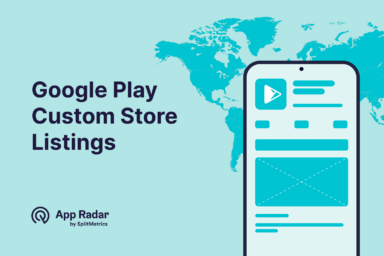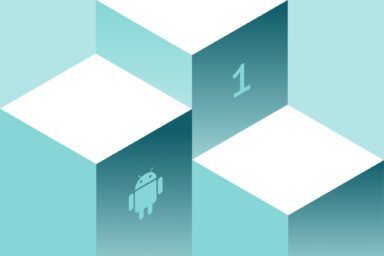Similar Apps in Google Play: Are They Important for ASO?
Similar apps on Google Play are a curated list of apps that the store algorithm finds related to the app currently being viewed. Similar apps help users discover new apps that align with their interests or needs based on the app they are currently exploring. This feature is visible at the bottom of an app's store page and sometimes directly in the search results.
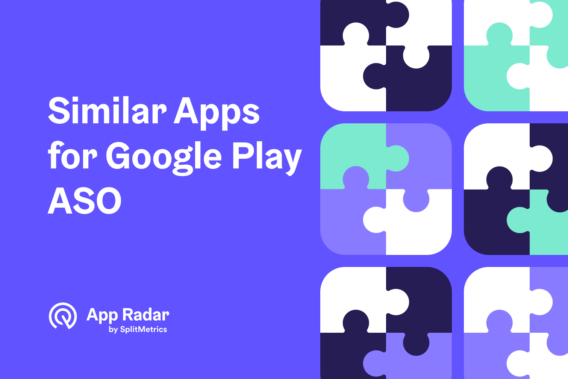
Understanding how your app interacts with search functionalities and category placements in Google Play Store significantly impacts its visibility, the number of downloads and overall success.
That is why similar apps section is crucial for app developers and marketers, as it provides valuable insights into app discovery and user perception.
How do Similar Apps Impact Google Play ASO?
Similar apps section can drive significant exploration traffic, which refers to users discovering apps through browsing rather than searching. All this impacts the results of an app’s app store optimization efforts (ASO).
Being listed under similar apps increases an app’s visibility, potentially leading to higher download rates and improved ASO performance by broadening the audience reach beyond direct search queries.
Below is an example of similar apps recommendations for one fitness app. These recommendations are normally pushed down on the store landing page, but they can still influence an app’s user acquisition.
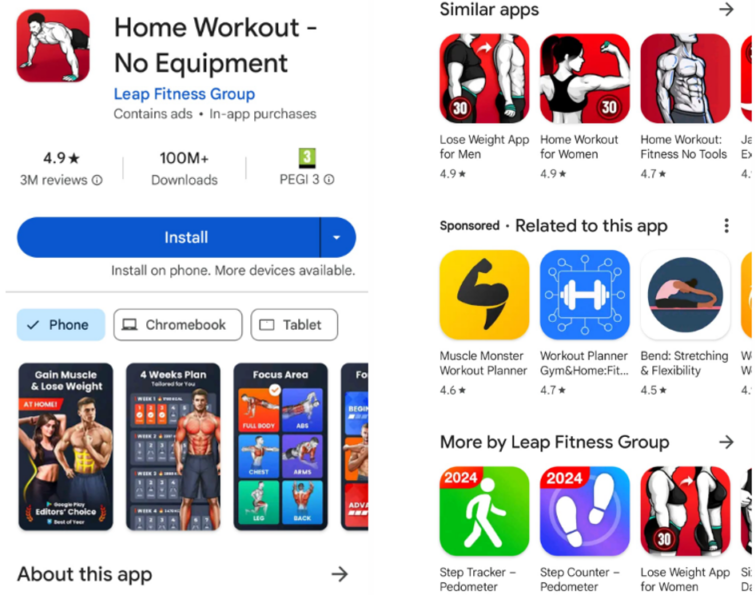
How Can an App be Listed in the Similar Apps Section?
While Google has not publicly disclosed the exact mechanics behind the selection for similar apps, it is influenced by several factors. Those factors include app metadata, user behavior such as the apps they have previously downloaded or interacted with, and other undisclosed algorithmic elements.
To enhance your app’s chances of appearing in similar apps section, focus on optimizing its metadata with relevant keywords, maintaining high user engagement, and ensuring it is accurately categorized.
We’ll explore the mentioned factors in the heading below.
Which Factors Impact Similar App Recommendations?
The recommendations for similar apps involve a combination of factors, including the app’s category, keywords, user engagement metrics, and user reviews.
Sometimes being mentioned in the similar apps section means that an app can improve its chances of being recommended alongside similar high-quality apps and drive more downloads and user engagement.
Here’s a breakdown of each factor:
FACTOR 1: App Metadata (Title, Description, Keywords)
The textual content within an app’s metadata, including its title, description, and keywords, is crucial in determining similar app recommendations.
These elements help the algorithm understand the app’s purpose, functionality, and target audience. For instance, apps with similar keywords in their titles or descriptions are more likely to be recommended alongside each other.
This underscores the importance of carefully selecting relevant and specific keywords that accurately reflect the app’s core offerings.
FACTOR 2: User Engagement Metrics (Downloads, Active Users, Retention Rates)
Apps that exhibit high user engagement metrics, such as a large number of downloads, a high number of active users, and strong retention rates, are often considered more relevant and are, therefore, more likely to appear in similar app recommendations.
These metrics indicate the app’s popularity and user satisfaction, which are key factors in recommendation algorithms.
High engagement levels signal to the algorithm that the app is valuable to users, making it a good candidate for recommendation.
FACTOR 3: User Reviews and Ratings
The quality and quantity of app’s user reviews and ratings significantly impact similar app recommendations.
Apps with higher ratings and positive reviews are perceived as more trustworthy and of higher quality, making them more likely to be recommended.
These user-generated inputs provide direct feedback on the app’s performance and user satisfaction, which the algorithm uses to assess the app’s relevance and quality.
FACTOR 4: App Category and Subcategory
The category and subcategory an app belongs to are fundamental in determining its appearance in similar app recommendations.
Apps within the same category or closely related subcategories share a thematic or functional similarity, making them more relevant to users interested in that particular genre.
This categorization helps with the recommendation process by grouping apps that serve similar purposes and interests for different users.
FACTOR 5: In-App Purchases and Monetization Strategies
The presence of in-app purchases and the app’s monetization strategies can also influence similar app recommendations.
Apps that offer similar in-app purchase options or employ comparable monetization models may be grouped as they appeal to users with similar spending behaviors or value perceptions.
The algorithms probably work on ensuring that users are presented with apps that match their willingness to pay for additional features or content.
FACTOR 6: Developer Reputation and Portfolio
The reputation of the app developer and the overall quality of their app portfolio can affect similar app recommendations. Developers known for producing high-quality apps are more likely to have their other apps recommended.
What matters here is the developer’s track record in creating engaging, reliable, and user-friendly apps, contributing to the overall ecosystem of quality app recommendations.
FACTOR 7: Geographical and Language Similarities
Apps targeting similar geographical regions or available in the same languages may be recommended together.
Cultural and linguistic relevance of apps to their potential users is always important, so Google wants that the recommendations are tailored to the user’s location and language preferences.
Geographical and language similarities also help provide a personalized app discovery experience, enhancing user satisfaction.
What are the Differences Between Similar Apps and Referring Apps?
Similar apps are suggested based on their relevance to the app being viewed, focusing on offering users alternatives or complements within the same category or usage context.
On the other hand, Referring Apps are those from which users have navigated to reach a particular app, indicating a direct linkage or promotional activity between apps.
How to Monitor Visibility from "Similar Apps" Collections?
Monitoring visibility from similar apps can be partly done by tracking Explore traffic within Google Play Console.
Analyze the acquisition reports to see how many users discover your app through this feature. This data can help you understand the impact of being listed in similar apps and adjust your ASO strategies accordingly.
Here’s a step-by-step guide to effectively monitor your app’s visibility within these collections:
Step 1: Regularly Check Your App’s Store Page
- Navigate to your app’s page on the Google Play Store either through a web browser or the Google Play Store app on a mobile device.
- Scroll down to the “Similar Apps” section. This section is typically located below the app’s description and reviews.
- Take note of the apps listed. These are the apps that the Google Play algorithm considers similar to yours based on various factors, including category, keywords, and user behavior.
Step 2: Use Google Play Console
- Log into Google Play Console: Access your Google Play Console account where your app’s data is managed.
- Navigate to the Acquisition Reports: Go to the “Store perfrormance” section, then click on “Store Analysis” This section provides a detailed breakdown of how users find your app on Google Play
- Within the acquisition reports, filter the traffic by selecting “Explore” as the traffic source. This filters the data to show only the users who discovered your app without directly searching for it
- Analyze the Explore traffic – while you can’t get the exact data for similar apps, you can still understand how similar apps contribute to your total organic user acquisition.
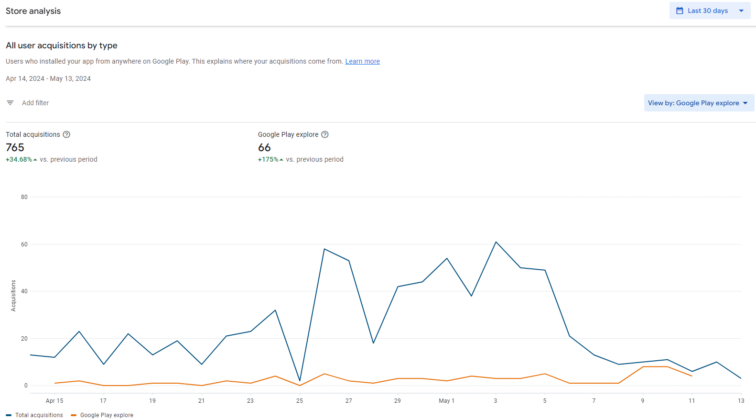
Step 3: Keep an Eye on the competitors and the Similar Apps Section
- Identify and analyze the competitor apps listed as similar. You should be able to notice why they are considered similar and how you can improve your app’s positioning.
Step 4: Regularly Update and Optimize Your App
- Optimize your app’s metadata. Regularly update your app’s title, description, and keywords to ensure they accurately reflect your app’s content and functionality. This can influence your app’s visibility in the “Similar Apps” section.
- Improve your app’s quality and user engagement. High-quality apps with positive user ratings and engagement metrics will likely be featured prominently in similar collections.
- Release regular updates. Regularly updating your app with new features, bug fixes, and performance improvements can positively impact its visibility in the “Similar Apps” section.
Step 5: Monitor Changes and Adjust Strategy Accordingly
- Adjust your ASO strategy based on your findings. If you notice improvements in your app’s visibility in similar app collections, identify what changes contributed to this success and continue to refine your strategy based on these insights.
Closing Thoughts on How to Increase App Visibility with "Similar Apps"
To leverage similar apps for increased visibility, ensure your app is fully optimized with accurate and relevant metadata, engage actively with users to maintain high ratings, and consider running marketing campaigns encouraging more users to view and download your app.
Additionally, regularly updating your app with new features helps maintain its relevance and attractiveness, increasing the chances of being featured in similar apps.
Latest Posts

iOS App Product Page Localization: How to Use it the Right Way to Improve ASO
Top 10 Most Downloaded Games in Google Play Store (July 2025 Update)
Google Play Store Listing Experiments: How to Run Native A/B testing for Android Apps for Free!
12 Best Mobile Measurement Partners (MMPs) to Consider for Your Mobile App Attribution in 2025
Related Posts
